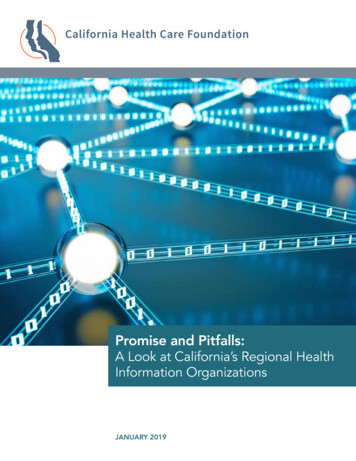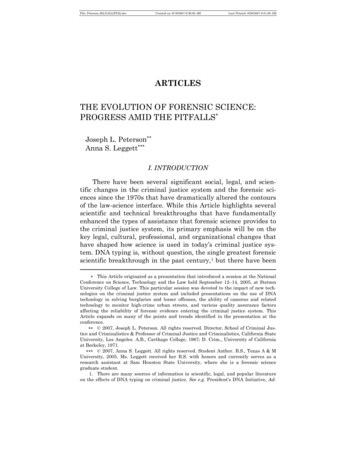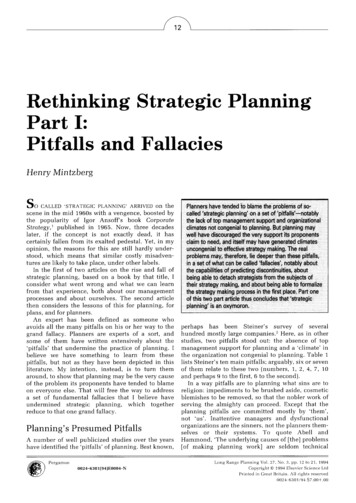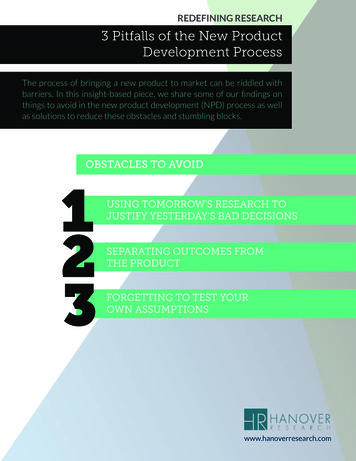
Transcription
Promise and Pitfalls:A Look at California’s Regional HealthInformation OrganizationsJANUARY 2019
ContentsAbout the Author3 IntroductionWalter Sujansky, MD, PhD is the principal consultant at Sujansky & Associates, a California-basedconsulting firm that specializes in the analysisand design of EHRs, disease registries, and solutions for health information exchange.4 What Is an HIO?AcknowledgmentThe author thanks the many HIO leaders andother experts who provided valuable insightsand data used in this report. Thanks also toRoss Martin of 360 Degree Insights and MelissaSchoen of Schoen Consulting who helped withthe research and interview processes.About the FoundationThe California Health Care Foundation isdedicated to advancing meaningful, measurable improvements in the way the health caredelivery system provides care to the people ofCalifornia, particularly those with low incomesand those whose needs are not well served bythe status quo. We work to ensure that peoplehave access to the care they need, when theyneed it, at a price they can afford.CHCF informs policymakers and industry leaders, invests in ideas and innovations, andconnects with changemakers to create a moreresponsive, patient-centered health care system.For more information, visit www.chcf.org.6 Types of HIOs1. Regional2. Enterprise or Private3. EHR Systems That Enable Data Exchange4. National Vendor-Sponsored5. HIOs That Connect HIOs6. Niche Commercial Data-Exchange Services7 High-Value Use Cases10 Current Challenges and Potential Paths Forward14 Types of Entities That May Participate inRegional HIOs17 Snapshot of Nine California Regional HIOs27 How Regional Market Dynamics Shape the Roleof Regional HIOsKey FactorsCase Studies: Real-World Implications of Regional MarketDynamics on HIO Strength29 Looking Ahead: Policy and Technology Trendsto WatchNew HITECH Funds on the Horizon for California’sRegional HIOsThe Potential of TEFCAFast Healthcare Interoperability Resources (FHIR)BlockchainConsumer-Mediated Health Information Exchange31 Conclusion32 EndnotesCalifornia Health Care Foundation2
IntroductionEach time a person comes in contact with a healthcare or social service entity, some amount of newdata about that person is created. It could be assimple as their current weight or employment status, oras complex as a summary of a two-week hospital stay.All too often, entities must share in the care of a patientwithout actually being able to share much of the valuable data they hold about that patient. The inability toexchange information can result in care rife with some ofthe industry’s worst flaws, including wasteful spending,poor coordination, and reactive rather than preventivecare. This report examines the various types of healthinformation exchange (HIE) resources available toprovider organizations in California, the value that stakeholders are seeking to realize from such resources, andthe specific role of nonprofit regional health informationorganizations (HIOs) within this landscape.Government and private enterprise have both recognized the value of improving the ability of entities insideand outside of the health care system to easily exchangedata that could inform patient care. On the governmentside, initiatives and incentives to promote the exchangeof health information have ranged from sweeping federalefforts to more limited local ones. On the federal level,the Health Information Technology for Economic andClinical Health (HITECH) Act, passed in 2009, has beenone of the most influential legislative efforts. It has offeredbillions of dollars in financial incentives focused on twoprimary goals: first, increasing adoption of electronichealth record (EHR) technologies; and second, enablingentities to share this newly created wealth of electronichealth information through the creation of HIOs.In California, EHR adoption flourished uniformly, whilethe growth of HIOs was more fragmented. State government efforts to standardize and coordinate HIOdevelopment across the large California marketplacewere largely superseded by local market dynamics anddevelopment trajectories. Parts of the California providermarket are dominated by large private health systems,many of which could afford to purchase robust EHRsystems and develop private, exclusive HIOs to enablethe exchange of data within their health systems. Manysmaller provider entities, often members of the safetynet or independent physician communities, were left outof the more robust EHR and private HIOs and, as a result,often lacked early access to data-exchange capabilities.Some providers participated in efforts to create nonprofitalternatives to private data-exchange networks, knownas community-based or regional HIOs, and at least ninesuch entities operate across various parts of the statetoday. Participation in these networks, however, hasbeen variable and, in many regions, has not yet reachedthe critical mass needed to provide maximal value andachieve financial self-sustainability.At the same time, the EHR vendor market has beenconsolidating, with fewer vendors serving an increasingproportion of provider organizations in the state. Certainof these vendors have created capabilities to enablerobust data sharing among the customers of their ownproducts, and also collaborated with each other to createbasic data-sharing networks across their products. Thesedevelopments have created new avenues for interoperability among the provider organizations using EHRs fromthese largest of vendors. However, they have also furthermarginalized provider organizations that continue to useEHRs not yet participating in these vendor-based datasharing networks or using older versions of EHRs thatdo not have these data-sharing features. In many cases,these providers, especially in the outpatient setting,comprise smaller, independent physicians and community clinics that serve the safety-net population.Hence, for independent providers and safety-net clinics,nonprofit regional HIOs remain an important means toconnect and exchange data with collaborators in theircommunities. Because they are community-run and aimto achieve total regional connectivity through inclusivity,regional HIOs offer a healthy counterbalance to trendsin the private market. They guard against any one EHRvendor or other corporate entity gaining too much control over vital data-exchange capabilities. They are alsoespecially well suited to meet the needs of safety-netpatients and the providers who care for them. For example, a regional HIO can include nontraditional serviceproviders, such as housing agencies or substance-usetreatment facilities, that are vital to the well-being ofvulnerable populations but are otherwise excludedfrom data exchange occurring via EHRs or within privatehealth systems. Also, the nonprofit nature of regionalHIOs fosters collaboration and communication amongmembers of competing health systems and EHRs thatprivate-market forces might otherwise inhibit. This collaboration is especially critical for the care of safety-netpatients, whose frequent use of emergency services1and specialty care referrals2 makes them more likely toPromise and Pitfalls: A Look at California’s Regional Health Information Organizations3
see providers belonging to multiple health systems andusing multiple EHRs.While regional HIOs have come a long way in Californiasince the first one was founded in Santa Cruz in 1996,they have a long road still to travel before they fully realize their potential to help create more connected andcoordinated care systems within the state. Regional HIOscurrently touch an estimated 22 million lives in the state,but only about half of California’s hospitals participate,and 23 of California’s 58 counties still lack any significantregional HIO presence. Many regional HIOs are struggling to find sustainable financial footing and to provetheir value in the face of well-funded private alternatives.Investing in their success offers a tangible path to tackling the fragmentation in California’s health care system,which remains a persistent source of frustrations, inefficiencies, and disparities.What Is an HIO?In general, health information exchange organizations, also known as HIOs, are entities that facilitate theexchange of patient health information among the enterprises comprising a health care delivery system. Theycan be either community-based and nonprofit, known inCalifornia as regional HIOs, or owned and operated by aprivate enterprise.Components of HIOsTechnical Components Implementeddata interfaces. The HIO’s meansof sending and receiving patient data; sometimesincludes user-interface features integrated within theexisting EHR systems of participating enterprises. Masterpatient index (usually). Consolidates patientdemographic information and unique identifiersacross participating enterprises for the purpose ofmatching a person’s clinical information held bydifferent providers. Record-locatorservice (sometimes). Tracks the presence and location of specific patients’ data amongthe participating enterprises. Patient-datarepository (sometimes). Centrallyaggregates, normalizes, and stores patient datasubmitted by participating enterprises. Many HIOs,however, just transmit patient data from point A topoint B and do not maintain a persisted copy ofthe data. Data-sharingapplications (usually). Provide various functions, including search, document retrieval,alerts, and data analysis, for the patient data that areaccessible via the HIO. The most commonly includedapplication is a web-based portal for the search and/or retrieval of patient documents. Other applicationsmay include a subscription and routing mechanismfor event notifications (e.g., inpatient admissions) ora bulk data-export capability to populate analyticaldatabases and population-health tools.No two HIOs are exactly alike, but they typically have similar organizational and technical components to enablethe sharing of patient data among their participants.Organizational Components Documenteddata-exchange standards. Agreedupon formats for the exchange of health informationthat all participating enterprises will support. Participationagreement. Formalized relationshipbetween the HIO and the enterprises that participatein it, including payment terms and legal obligations. Data-useagreement. Agreed-upon allowed usesof data received via the HIO — for example, limitinguse to treatment purposes or prohibiting the bulkaggregation of data for insurance-contracting purposes.California Health Care Foundation4
Distinct Technology ModelsAlthough HIOs share many components, a key distinction among many of them lies in the technology models thatunderlie their data infrastructures. The technology model that an HIO chooses fundamentally shapes how it collects,organizes, and exchanges its data, and therefore what use cases it can offer its members. There are three commonlyused technology models: federated, hybrid, and centralized models.Centralized ModelBENEFITSThe centralized model operates like a hub and spokewhereby data are physically aggregated and managedcentrally. An HIO is responsible for operating the centralized technology and making that clinical informationavailable to HIO participants through it for permittedpurposes agreed to by those participants. QuicklyBENEFIT Richset of aggregated and consolidated patientdata, enabling more analytical use casesCONSTRAINTS Difficult Moreto normalize and standardize datadifficult to scale Requiresgreater trust among participating membersFederated ModelIn the federated model, data are stored and managed by a distributed network of HIO members. Thesepeer organizations adopt standards and processes forsharing information under a common legal agreementamong participants. If each participant adopts the ability to communicate by those standards, participants canquery one another to search for information on common patients without relying on any central technologyoperator. Lowerscalablecost to implementCONSTRAINTS Limitedpotential for data consolidation and analysis Lowerlikelihood of matching patients’ data betweenorganizationsHybrid ModelThe hybrid model is similar to the federated model inthat it mostly relies on legal and governance agreements, but it has a thin layer of technology thatcentralizes some patient data, like identities and recordlocator services. This thin layer of technology andcentralized data storage serve to improve the coordination of data exchange.BENEFIT Morescalable than fully centralized modelCONSTRAINT Limitedpotential for use cases that requiredata analysisNote: For a more detailed comparison of these technical models, refer to Douglas B. McCarthy et al., “Learning from Health Information ExchangeTechnical Architecture and Implementation in Seven Beacon Communities,” eGEMs (Generating Evidence & Methods to improve patient outcomes)2, no. 1 (May 5, 2014), accessed December 14, 2018, www.ncbi.nlm.nih.gov (PDF).Promise and Pitfalls: A Look at California’s Regional Health Information Organizations5
Types of HIOsGenerally, any entity facilitating some form of HIE activity,regardless of the underlying technology or governancemodel it uses, can be considered an HIO. Such entities can generally be grouped into one of the followingcategories:1. RegionalRegional HIOs are distinct from other HIE resources inthat they (1) serve defined geographical regions, rangingfrom a single county to an entire state; (2) are open to anyhealth care enterprise that serves patients in a region,regardless of its business affiliations or choice of information technology vendors; and (3) are nonprofit entitiesprimarily concerned with improving the quality and costeffectiveness of health care in a region through greateravailability and sharing of patients’ health information.Examples of regional HIOs in California include ManifestMedEx, Santa Cruz HIO, and North Coast HealthImprovement and Information Network.While regional HIOs can offer a healthy counterbalanceto more exclusive private-market options for exchangingdata, they do face unique constraints. Chief among themis financial sustainability. In California, most regional HIOsrely on a mix of subscription fees and philanthropic orgovernment grants. If one or more large hospitals in agiven region opts to build a private HIE network insteadof participating in the regional HIO, then that HIO maylose critical subscription revenues and may be forced toraise rates on smaller entities. In turn, those entities mayopt out of the regional HIO themselves, due to budgetary constraints. Ultimately, the HIO may become overlydependent on grant funding, the long-term availability of which can be unpredictable. Another challengefor regional HIOs is that many provide access to dataprimarily through a web portal rather than via full EHRintegration. EHR integration is more costly for regionalHIOs to implement, but far more attractive for busy provider users.2. Enterprise or PrivateAn enterprise HIO is built specifically to meet both thefinancial and clinical objectives of a distinct businessentity such as a hospital system, independent physicianassociation (IPA), integrated delivery network (IDN), orCalifornia Health Care Foundationaccountable care organization (ACO). While these HIOscan include many different participants, such as hospitals,clinics, laboratories, and even payers, they are typicallyopen only to organizations contractually partnered withthe business entity that built the HIO. That purchasingentity has sole control over the exchange’s data andavailable features.Examples of enterprise or private HIOs in Californiainclude those operated by Kaiser Permanente, SharpHealthCare, Dignity Health, and Monarch HealthCare.While private HIOs are often perceived as presentingfewer legal and business liabilities than regional HIOs,they do have limitations. For example, provider organizations can exchange data only with other organizationsthat are part of the same business entity served by theprivate HIO. Data generated at “outside” provider organizations — at which a patient currently “in network” mayhave been seen in the past or in an emergency — aretherefore not available. Furthermore, business entitiesmust finance the entirety of the private HIO licensing andoperations and cannot share those costs with outsideorganizations that might otherwise be part of and contribute financially to a more inclusive exchange, such asa regional HIO.3. EHR Systems That Enable DataExchangeWhen a single EHR system has been widely adopted ina particular region and it contains robust data-exchangefeatures, that EHR can act in some ways like an HIO. Dataexchanged through the EHR has the advantage of alwaysbeing integrated directly into the EHR user interface.Provider organizations can also import patient recordsfrom other facilities that use the same EHR and haveenabled its data-exchange features.By far the most prominent example in the state is Epicand its Care Everywhere network. The Epic EHR is widelyused in California by many hospital systems (e.g., Sutter,Providence, Memorial Care), academic medical centers (e.g., Stanford, UCSF, UC San Diego, UCLA), IDNs(e.g., Kaiser Permanente, Scripps Health, Cedars-Sinai),and community clinic networks (e.g., OCHIN [OregonCommunity Health Information Network], CommunityMedical Centers).6
On the downside, provider organizations cannot accesspatient records from facilities that use other EHRs orhave not enabled their EHR’s data-exchange features.Furthermore, there is no centralization or curation ofpatient identities, so matching rates can be poor anddepend on the quality of patient demographic information provided by the two facilities attempting to exchangedata. EHRs also often lack the more robust features thatcertain regional and private HIE networks provide, suchas encounter notifications, referral management, resultsdelivery (i.e., “pushing” patient data), or the ability toaggregate and analyze patient data in bulk across multiple EHR instances.6. Niche Commercial Data-ExchangeServicesThere are numerous commercial, for-profit companiesthat provide specific data-exchange services to medical communities. Services tend to focus on a particularaspect of care, such as the sharing of controlled substanceprescribing data across hospital emergency departments(EDs), the sharing of patients’ Physician Orders for LifeSustaining Treatment (POLST) directives, or the sharingof care plans for care coordination.Examples of vendors providing such services includeCollective Medical Technologies, ACT.md, and Vynca.4. National Vendor-SponsoredThis type of HIO is funded and operated by a consortium of commercial vendors who have the shared goal ofenabling interoperability among their respective healthinformation technology (IT) products, such as EHRs.Access to the network is typically tightly integrated intoeach vendor’s respective IT product and available to itscustomers with minimal custom development or configuration. Since these networks’ members tend to be EHRvendors, they present benefits (data integrated directlyinto the EHR) and challenges (less robust features, inability to access data from facilities that have not joined thenetwork or use a nonmember EHR) similar to the aforementioned individual EHRs offering HIO-like exchange.Examples of national vendor-sponsored HIOs includeCarequality, whose network is available to users of Epic,athenahealth, eClinicalWorks, and NextGen HealthcareEHRs; CommonWell Health Alliance, whose network isavailable to users of Cerner, Meditech, Evident, athenahealth, eClinicalWorks, and Greenway Health EHRs; andDirectTrust.5. HIOs That Connect HIOsThese HIOs serve as “gateways” between other existingnetworks, including enterprise HIOs and regional HIOs.They provide services to normalize searches for anddelivery of patient data across distinct HIOs, which canhave differing data formats and standards.Examples nationwide include eHealth Exchange andStrategic Health Information Exchange Collaborative(SHIEC).High-Value Use CasesFrom high hospital readmission rates to the costly ordering of duplicative tests, there are many major pain pointsin health care that persist at least in part because providers are unable to easily exchange information withone another about the patients they share. The abilityto exchange information will only grow more importantas the United States health care system increasinglyembraces value-based payment models. These newmodels will require payers and providers to better understand which of their patients are at risk for poor outcomesand then effectively target resources, from both withinand outside of the traditional health care system, toprevent those outcomes. That shift will require manynew capabilities, including robust data collection andanalysis, and proactive coordination with nontraditionalentities that have an outsized effect on health, such asfood banks and housing authorities.The good news is that research has shown that HIOs canhelp providers meet these new expectations. SubstantialHIO adoption has been associated in some studies with alower rate of hospital readmissions, fewer ED admissions,fewer duplicated procedures, improved medication reconciliation, greater immunization and health recordcompleteness, better identification of drug-seekingbehaviors, and reduced total cost of care.3 WhetherCalifornia will eventually reap similar benefits dependson both increasing HIO participation rates and strengthening the capabilities of the HIOs to ensure they deliverthe utmost value.Promise and Pitfalls: A Look at California’s Regional Health Information Organizations7
The use cases outlined in Table 1 comprise the six areasin which regional HIOs in California are focusing themajority of their efforts related to enhancing their capabilities and ultimately delivering greater value to theirmembers. Although the different regional HIOs are supporting these use cases to varying degrees today, mosthave acknowledged and prioritized them as high-valuegoals to pursue.Table 1. Six Use Cases of Regional HIOs in California, continuedUSE CASE / DESCRIPTIONLongitudinal patient record. HIOscan provide access to patients’ healthinformation originating from numerous sites of care either by aggregatingdata from across sites into a singlephysical patient record or by enablingretrieval of data on demand fromsuch sites, effectively creating a singlevirtual patient record.Real-time event notification. HIOscan establish “publish/subscribe”infrastructures, in which certain clinical events are always reported to theHIO, which then forwards informationabout the events to parties that haveexpressed interest in being notifiedof them. This mechanism can beconfigured on an event-specific andpatient-specific basis. For example,the care-management team at a healthinsurer could be notified each timea high-risk patient is seen in an ED,or a primary care physician could benotified upon the discharge of one ofher patients from the hospital.Results reporting and documentdelivery to ambulatory providers.An HIO can provide a central “hub”for receiving, translating, and forwarding diagnostic results and clinicaldocuments between hospitals andoutpatient providers. In this model,each hospital and outpatient providerneed only maintain a single interfaceto the hub, which translates the dataformats appropriately to accommodate all senders and recipients. Thisapproach replaces the highly inefficient and costly process of having eachhospital and outpatient organizationwithin a given health care ecosystemmaintain numerous electronic datainterfaces and perform many separatedata translations.California Health Care FoundationCLINICAL VALUE Reduces potential forerrors caused by poorinformation about allergies, prior treatments,and other information critical to clinicaldecisions. Increases clinicians’chances of makingwell-informed andevidence-based caredecisions. Enables proactiveintervention, timelyoutpatient follow-upafter ED visits andhospital discharges, andtracking of patients’attendance at importantspecialist visits. Recovers time otherwise spent by clinicaland administrative stafftranslating, faxing, andreceiving diagnosticresults and clinicaldocuments. Moves test results andclinical documentsthat otherwise exist infragmented faxes intothe EHR, allowing themto more easily informclinical decisionmaking.BUSINESS VALUEDATA REQUIRED Enables provider entitiesthat bear financial riskto avoid poor clinicaloutcomes and wasteful utilization, such asredundant testing. Medication allergies;results of past laboratory, imaging, and otherdiagnostic procedures;previously diagnosedand treated disorders;currently or previouslytaken medications; andsites and frequenciesof previous medicalencounters Enables stakeholders todivert patients to morecost-effective sites ofcare and to preventcostly avoidable hospitaladmissions by intervening proactively andarranging alternativecare arrangements. Relevant health careevents warrantingnotification may includeED visits, hospitaladmissions, hospitaldischarges, and appointments for specialistvisits. Hospitals provide thedata for ED visits, hospital admissions, andhospital discharges,typically via HL7 ADT(“admit/discharge/transfer”) messages. Thereferring and/or consulting physician provide(s)the data for scheduledspecialist visits.Saves time and moneyspent on the staff andtechnologies requiredto maintain numerouselectronic data interfaces to different tradingpartners. Test results and clinical documents fromhospitals sent via HL7interfaces to outpatientproviders, who receiveand integrate the datainto their EHRs 8
Table 1. Six Use Cases of Regional HIOs in California, continuedUSE CASE / DESCRIPTIONData submission to public healthagencies. For provider organizationsthat are already submitting lab resultsand immunization data via somemeans of data exchange, the HIOcould analyze, appropriately format,and transmit these data to the publichealth department on behalf of theprovider organizations. This modelobviates the need for provider organizations to build separate interfacesto public health agencies and canautomatically monitor all test results toidentify and transmit those that requirereporting.Data aggregation for populationhealth and utilization-managementanalytics. HIOs with data connectionsto numerous health care providerscan receive, integrate, and normalizeclinical data pertaining to individualpatients in a physical data repository.These data can then be made availablefor analysis to interested stakeholders,either by exporting the consolidatedrecords for all applicable patientsto the stakeholders, or by providinganalytical software to process the datadirectly on the data repository.Coordinating with nonmedicalproviders to address patients’ socialneeds. An HIO that is coordinatingcare between clinical provider organizations and delivering longitudinalpatient records, event notifications,and data aggregation can facilitate“whole person care” by including dataon behavioral health care, substanceuse treatment, and use of socialservices. An HIO can add additionalvalue by providing built-in tools forcare coordination, referral management, and patient tracking.CLINICAL VALUE Ensures more completerecords of patients’immunizations andreportable diseases,facilitating and improving their future care.BUSINESS VALUE Saves time and moneyspent monitoring testresults for those thatrequire reporting topublic agencies. Saves time and moneyspent building andmaintaining the separateinterfaces required tocomplete electronicsubmissions, or spentmanually submitting viaweb portals. Enables proactive identification of patients atrisk for certain pooroutcomes and theproper allocation of caremanagement resourcesneeded to avoid thoseoutcomes. Enables proactive identification of patients atrisk for costly and avoidable outcomes and theproper allocation of caremanagement resourcesneeded to avoid thoseoutcomes. Enables the proactive identification andcorrection of patientcare not alignedwith evidence-basedpractices. Enables retrospective analysis of careoutcomes and costsacross a population toidentify patterns associated with higher-valuecare. Enables care managersto better facilitate carecoordination and followup on necessary referrals for both social andmedical needs. Better targets resources,both medical and social,to avoid more costly andavoidable outcomes,such as hospitalization. Enables providers tomore effectively screenfor and address thesocial factors that canharm a person’s health.Better tracks andmeasures the cost-effectiveness of social servicereferrals with respect tomedical utilization.DATA REQUIRED Diagnosis, immunization, and other clinicaldata required by healthagencies and submittedby hospitals and outpatient providers In California, theCalREDIE (reportablediseases) and CAIR2(immunizations) publichealth registries receive,store, and processthese data. Clinical data in longitudinal patient records;claims records fromhealth insurers Data on behavioralhealth care, substanceuse disorder treatment, and use of socialservices — contributed by hospitals,outpatient clinics(including communityhealth clinics), countymental health facilities,substance use disorder treatment centers,homeless shelters, foodassistance agencies,employment agencies,and corrections facilitiesNotes: CAIR2 is California Immunization Registry; CalREDIE is California Reportable Disease Information Exchange; HL7 is Health Level Seven International.Promise and Pitfalls: A Look at California’s Regional Health Information Organizations9
regional HIOs include the nearly 200 California hospitalsnot currently participating in a regional HIO, other potential participant entities, vendors whose technologiescould improve HIO capabilities, state and federal officialswho can clarify and revise regulations to be more supportive of
EHR Systems That Enable Data Exchange 4. National Vendor-Sponsored 5. HIOs That Connect HIOs 6. Niche Commercial Data-Exchange Services 7 High-Value Use Cases 10 Current Challenges and Potential Paths Forward 14 Types of Entities That May Participate in Regional HIOs 17 Snapshot of Nine California Regional HIOs 27 How Regional Market Dynamics Shape the Role of Regional HIOs Key Factors Case .










